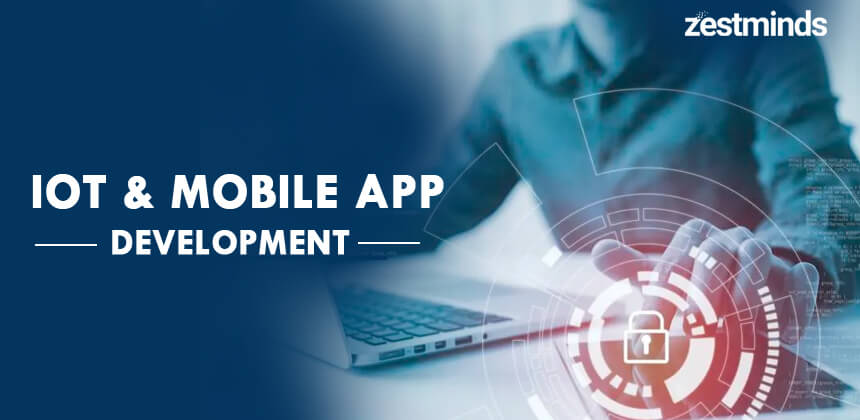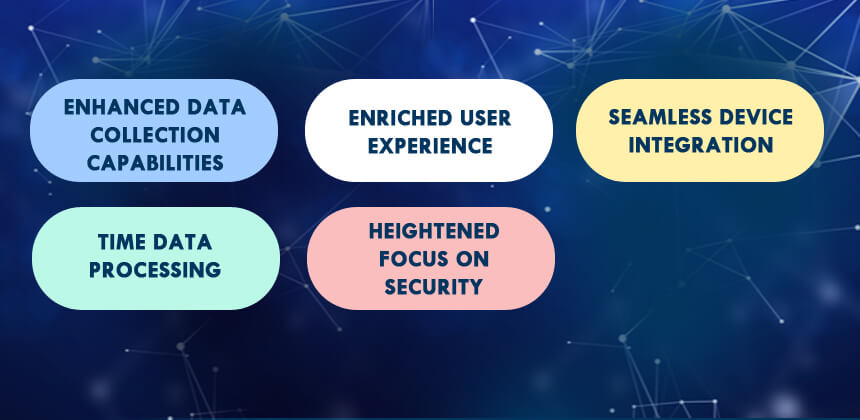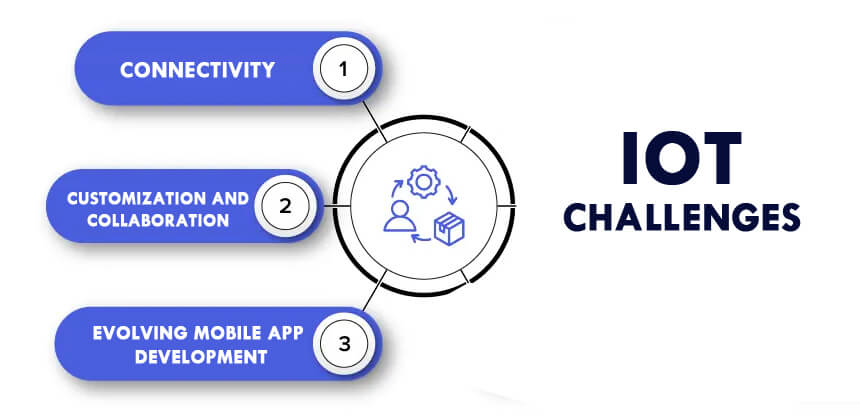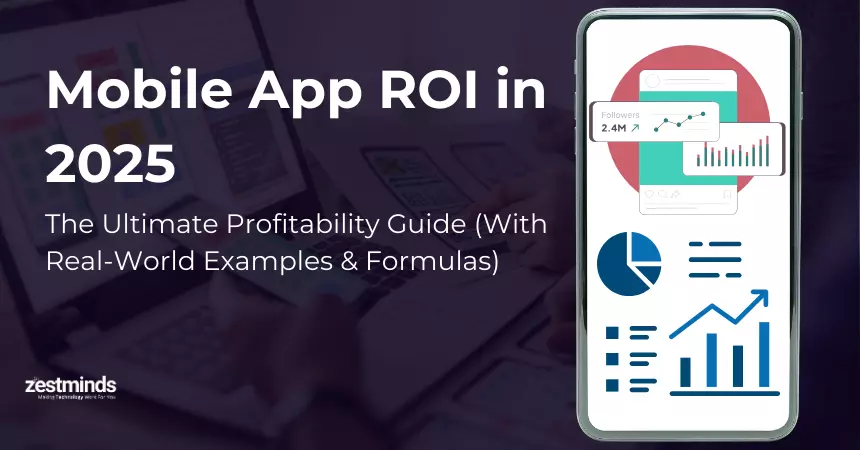Unleashing the Power of IoT: The Impact on Mobile App Development

Do you think about how the Internet of Things will change the way mobile apps are made? The Internet of Things has changed the way we use our gadgets, from smart homes to wearable tech. But have you thought about what the Internet of Things could mean for mobile apps?
As more and more devices connect to the internet, it's up to makers to find ways to make apps that work well with these devices and give users a smooth, unified experience.
So, it's time to buckle up, get your phone, and learn more about the future of mobile app creation in terms of IOT technology.
Let's start by taking a quick look at the latest market data!
Current Market Stats
The study shows that by 2026, the IoT market will be worth more than $1,100,000,000,000,000. From 2019 on, it will grow by 24.7% per year. Also, by 2030, there will be 125 billion IoT gadgets around the world.
In the world of mobile app development, IoT is getting steady steam. A new study says that the market for IoT app development is expected to grow by 24.3% over the next seven years. This growth is caused by things like the growing use of IoT devices and the rising demand for connected products and services.
COVID-19 has also made it easier for different businesses to use IoT. For example, by 2024, the number of IoT devices in the healthcare business is expected to grow from 651 million to 1.6 billion. The report also says that the pandemic has caused more people to want remote healthcare options, which has pushed the healthcare industry to use more IoT devices and apps.
The market for IoT gadgets and apps is growing as a whole. People who can make mobile apps that work well with IoT technology will likely be in high demand in the coming years.
What is Internet of Things (IoT)?
Before we talk about how IoT changes the way mobile apps are made, let's talk about what IoT is. It is a group of devices, cars, and other things that all have sensors, networks, and software built into them. These devices can gather and share data, which makes it possible to automate certain jobs and make things run more smoothly. The IoT ecosystem is made up of devices that are all linked to the internet, such as smart home appliances, wearables, and industrial machinery.

The Expanding Role of IoT in Mobile App Development's Future
As the IoT market continues to expand, mobile app developers must adapt by integrating IoT technology into their applications. This integration not only enhances data collection and analysis but also elevates the user experience. Let's delve deeper into the future of IoT in mobile app development.
1. Enhanced Data Collection CapabilitiesIoT enables the gathering of vast amounts of data from a wide array of connected devices. This data can be utilized to inform future development activities and tailor app experiences to individual users. For instance, a fitness tracker collects data on a user's physical activities, allowing developers to create personalized experiences based on the user's habits and preferences.
2. Enriched User ExperienceIoT technology can significantly enhance the user experience of mobile apps in various ways. By leveraging data from sensors and connected devices, mobile apps can provide personalized recommendations and features tailored to individual users. Furthermore, IoT-enabled devices can be integrated with mobile apps, enabling users to control these devices remotely. For example, a user can adjust their smart thermostat's temperature through a mobile app, even when they are not at home.
3. Seamless Device IntegrationThe popularity of smartwatches and fitness wearables with internet-connected apps is on the rise. These devices not only grant users remote access to app data but also deliver a seamless user experience. Developers can harness the data collected by these devices to enhance app features and provide regular updates.
4. Growing Need for Real-Time Data ProcessingIoT devices generate massive amounts of data, necessitating real-time processing by mobile apps to deliver meaningful insights to users. This requires the implementation of advanced technologies like machine learning and artificial intelligence to rapidly analyze data and offer actionable insights. Consequently, mobile app developers must possess a strong understanding of these technologies and know how to incorporate them into their applications.
5. Heightened Focus on SecurityWith the increasing proliferation of internet-connected devices, security emerges as a critical concern for both mobile app developers and iot. IoT devices and mobile applications are susceptible to cyber-attacks, putting users' personal information at risk and potentially leading to detrimental consequences.

Challenges of App Development in IoT
IoT technology presents both challenges and opportunities for mobile app developers. By embracing new connectivity methods, adapting to the unique requirements of IoT app development, and fostering collaboration between IoT device manufacturers and app developers, the industry can create innovative and engaging applications that cater to the evolving needs of users in an increasingly connected world. Here, we explore the challenges and opportunities that IoT presents for mobile app development.
1. Connectivity ChallengesIoT devices often rely on different connectivity methods than traditional mobile apps, which typically communicate via Bluetooth, Wi-Fi, or 3G/4G services. Developers must understand how their apps will connect to IoT devices and integrate with gateways or standalone devices. This requires mastering new protocols and technologies, which can be complex and time-consuming. However, overcoming these connectivity challenges can unlock new capabilities for mobile apps, as data networks and Wi-Fi limitations are no longer constraints.
2. Evolving Mobile App DevelopmentThe software development process for IoT apps differs from that of traditional mobile apps, as it involves unique tiers and considerations. Developers must recognize these differences from the outset and be prepared to learn new languages and techniques to ensure seamless integration between IoT devices and mobile apps. This learning curve may be steep, but it is essential for creating innovative and functional IoT applications.
3. Customization and CollaborationAs IoT technology continues to advance, app developers should focus on delivering products that offer customization across various devices. This will enable users to enjoy a seamless experience, regardless of the specific IoT device they are using. Collaboration between IoT device manufacturers and app developers will be crucial in achieving this goal, as it will facilitate the sharing of knowledge and expertise, ultimately leading to better products and user experiences.
Are you Prepared for the Change?
The convergence of mobile apps and IoT is undeniable, and those who haven't recognized the impact of IoT on mobile app development are falling behind. As the concept of IoT continues to evolve, smart devices have become increasingly prominent, with mobile devices acting as the primary interface for interacting with IoT-enabled devices.
The potential of IoT to enhance our lives is immense. Open-source platforms are currently providing valuable tools for developing IoT-friendly apps, fueling the growth of the IoT ecosystem. App developers are gradually embracing the IoT trend in their development processes, with a reported 24% increase in the number of developers working on IoT apps.
The continuous advancements in IoT are paving the way for a highly interconnected world, with mobile apps playing a central role. App developers now have the opportunity to create IoT apps where objects transmit information through sensors in real-time, seamlessly integrating the physical and digital realms.
The time has come for app developers to embrace the potential of IoT and build applications that tap into the vast possibilities of this technology. By leveraging the capabilities of IoT, mobile apps can provide users with a truly connected and immersive experience, revolutionizing the way we interact with our surroundings.
What Future of Mobile App Development Trends can you Expect?
The future of IoT and mobile app development brings forth several emerging trends that will shape the landscape. One such trend is the integration of artificial intelligence (AI) and machine learning (ML) into IoT devices and mobile apps. AI and ML algorithms can analyze the vast amount of data collected by IoT devices, enabling personalized experiences and predictive capabilities. For instance, smart home apps can learn users' preferences and adjust temperature and lighting settings accordingly.
Another trend on the horizon is the development of more advanced wearable devices that seamlessly connect with mobile apps. These wearables, such as smartwatches and fitness trackers, collect real-time data on health and activity levels, providing users with valuable insights. Mobile apps can leverage this data to offer personalized fitness plans, track sleep patterns, or even detect potential health issues. For example, a mobile app connected to a smartwatch can notify users of irregular heart rate patterns and encourage them to seek medical attention.
The fusion of IoT technology with augmented reality (AR) and virtual reality (VR) is also an exciting trend to watch. AR and VR have already shown immense potential in various industries, and their integration with IoT can enhance user experiences further. Imagine a mobile app that uses AR to overlay digital information onto real-world objects, allowing users to interact with IoT devices in a more intuitive and immersive way. For instance, a maintenance app can use AR to provide step-by-step instructions on repairing a household appliance by overlaying virtual diagrams and animations onto the physical object.
As the IoT ecosystem expands, ensuring robust security measures will remain a top priority for developers. The interconnected nature of IoT devices and mobile apps opens up potential vulnerabilities that can compromise user data and privacy. Developers must implement stringent security protocols, such as end-to-end encryption, multi-factor authentication, and regular firmware updates, to safeguard against cyber threats. For example, a home security app that controls IoT-enabled locks and cameras should prioritize encryption to prevent unauthorized access and protect users' homes.
Bottom Line
The future of mobile app development with IoT technology is undeniably promising and impactful. The integration of IoT into mobile apps enables developers to unlock new features and functionalities that enhance user experiences. As the number of connected devices continues to rise, the influence of IoT in app development will only grow stronger.
It is crucial for developers, businesses, and app users to stay informed and embrace the potential of IoT in the mobile app landscape. By leveraging IoT technology, developers can create innovative and seamless experiences for users, while businesses can tap into the vast possibilities that arise from connected devices.
To make the most of this evolving field, partnering with reliable mobile app development services becomes essential. We at Zestminds Technologies provide cutting-edge solutions and expertise in IoT-enabled app development, ensuring that businesses and app users can harness the full potential of IoT technology.As we move forward, the future holds exciting possibilities for IoT in mobile app development. By staying abreast of the latest trends and advancements in this field, we can shape a future where mobile apps seamlessly integrate with IoT devices, delivering personalized experiences, real-time insights, and improved functionalities. Embracing IoT in mobile app development is key to staying ahead in the ever-evolving digital landscape.
If you want to use IoT, please get in touch with us right away. We'll help you use IoT to build an app that will work well in the future. Drop us an email at contact@zestminds.com and we shall discuss.

Shivam Sharma
About the Author
With over 13 years of experience in software development, I am the Founder, Director, and CTO of Zestminds, an IT agency specializing in custom software solutions, AI innovation, and digital transformation. I lead a team of skilled engineers, helping businesses streamline processes, optimize performance, and achieve growth through scalable web and mobile applications, AI integration, and automation.




